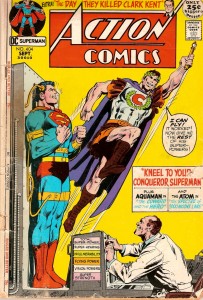 So last week, when I was discussing Action Comics #402, I was gloating about having had to pay only 15 cents for it. Little did I know that within two short months, my comics would undergo a 60% price increase. Yeah, okay, it was still only a quarter, but still, man, that’s steep.
So last week, when I was discussing Action Comics #402, I was gloating about having had to pay only 15 cents for it. Little did I know that within two short months, my comics would undergo a 60% price increase. Yeah, okay, it was still only a quarter, but still, man, that’s steep.
But the increased price was matched with increased content. Okay, it was very cheap content; DC was basically padding out the books with reprints of stories from the 40’s, 50’s and 60’s. But it was more value than you got with Marvel’s books, which were cheaper but had fewer pages. At least, such was my view then.
For example, here’s Action Comics #404, two issues after last week’s Vault offering. And like last week’s issue, there are two Superman stories drawn by Swan and Anderson, the lead written again by Leo Dorfman and the back-up written again by Geoff Browne. But there is also an Atom story from the 60’s, written by Gardner Fox and drawn by Gil Kane and Murphy Anderson, along with an Aquaman story from 1956. So, twice as many stories. That’s good, right?
In the first story, “Kneel to Your Conqueror, Superman,” Clark Kent is assigned by his boss Morgan Edge to do a story on the Coast Institute, a major scientific think tank.
His boss Who, you ask? Well, if you never read the comics, you would not realize that Clark had a long career as a TV reporter starting in 1970 when the Daily Planet was bought out by Galaxy Communications. You might recognize the name Morgan Edge from the TV series Smallville, but that character shares little more than a name with the original comics version.
So as Clark is nearing the Institute, he sees that it is about to be destroyed by an earthquake, so he performs a super-rescue of dubious scientific accuracy, then goes inside to make sure everyone’s all right. He then learns that everyone was expecting both the earthquake and his arrival to rescue them, because it was predicted by their resident super-genius, Rufus Caesar.
Caesar then invites Superman to his place, because Caesar is Superman’s biggest fan. In fact, he has an entire room in his house full of souvenirs from Superman’s many adventures.

Hint: when a creepy super-genius asks you to wear a funky-looking helmet, polite refusal may be your best course. Superman is paralyzed and becomes the prize exhibit in Caesar’s collection of Superman memorabilia.
But Caesar has more in mind than just tripling the value of his collection by “killing” the artist. He has built a machine that will transfer all of Superman’s powers into his body. He doesn’t just admire Superman, you see. He wants to be Superman, only smarter. He decides to try a couple of tests, and juices up his strength.

It’s really not flattering to abuse the help like that. Next thing you know, he’ll be threatening to rub sand in his dead little eyes. [Note: the clip with ask you to confirm your birthdate, but this particular lip is safe for work]
Superman resists as hard as he can, but Caesar continues to steal his powers one by one until his telescopic vision spots a cable car in danger, so he dresses in a Roman-style costume and prepares to do a total power transfer. At which point, Superman has a brainstorm.
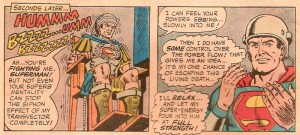
And quicker than the Hulk can very disturbingly tell his dad Nick Nolte to “take it all,” Caesar is feeling bloated by the sudden inrush of so much power. He tells his butler to flip the emergency stop switch, only the butler “accidentally” flips the “Super Power Reversal Circuit,” which restores all of Superman’s abilities. Must have been the sand in his eyes which caused him to confuse the switches. And of course, Caesar isn’t able to ask why they even have that lever, because the reversal also drained all his brain power, leaving him a vegetable. But Superman’s okay, so happy ending.
The Atom story is an example of DC as its most pedantic. “The Specter of 3,000 Moons Lake” reads like an episode of Scooby Doo crossed with Mister Wizard. Ray Palmer and his girlfriend are visiting friends when they encounter rumors of an ancient legend come to life, a ghostly medicine man who leaves glowing moccasin prints. But it’s just one of the neighbors trying to throw off suspicion as he steals the jewels of a rich couple who are also living by the lake, the Van Dorns. This story features one of the most over-explained, yet boring deathtraps I’ve ever seen.
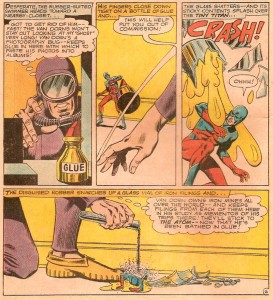
Got that? We spend a panel explaining the reason for the glue, and another panel explaining the reason for the iron filings. The frogman then picks up the Atom with a big horseshoe magnet, which attracts the filings, and tosses the whole shebang in the lake so Atom will drown. Too bad (as is explained later in the story) that the glue was water-soluble.
The third story features Aquaman in “The Coward and the Hero,” in which there’s a guy who looks just like Aquaman, only get this: he’s scared of water. But Aquaman recognizes him as a heroic Navy pilot who was shot down and stranded in the ocean for days, so he tries to repair the man’s reputation, with mixed results. It’s the dullest story in the issue (which is saying something), and also the only one not inked by Murphy Anderson.
The final story, “The Day They Killed Clark Kent,” features Clark as the world’s oldest-looking college student, trying to stop the evils of fraternity hazing. First he fakes slipping on soap so he can “accidentally” beat up a few frat boys…
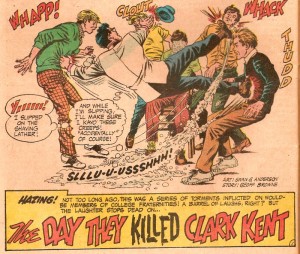
But then the frat guys decide to turn the tables by inviting him to join the fraternity, so they can haze him. So Clark uses his super-powers to trash their place so he can teach them a lesson. And when the lesson doesn’t take, he pretends to die. But one of the guys convinces the rest to stay and try to help Clark, so he doesn’t have them sent to jail for murder or something. And the boys learn their lesson and change their ways. Heartwarming, but man, even in college, Superman was a dick.
But there’s some nice art in the issue. Swan and Anderson were never the most exciting art team, but they produced good, solid work month in and month out, like this scene of Clark walking the plank.
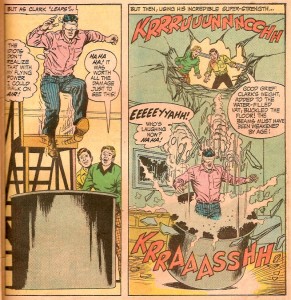
And while I obviously read the hell out of this issue (check out all the wear and the wicked spine roll on the cover above), looking back, this issue is a prime example of all the stuff that would cause a lot of fans to desert DC over the 60’s and 70’s for Marvel. Short, boring lead stories with barely any depth or continuity padded out with reprint filler that was somehow even more boring. DC would make several desperate attempts to fix those problems over the 70’s, with mostly bad results. Someday, once I’ve dug the right issues out of the Vault, I’ll put together some examples.
Oh, yeah, and that huge price increase? By the time Superman faced the Metropolis Monster, the price was back down to 20 cents and the the content was back down to two original stories per month.




